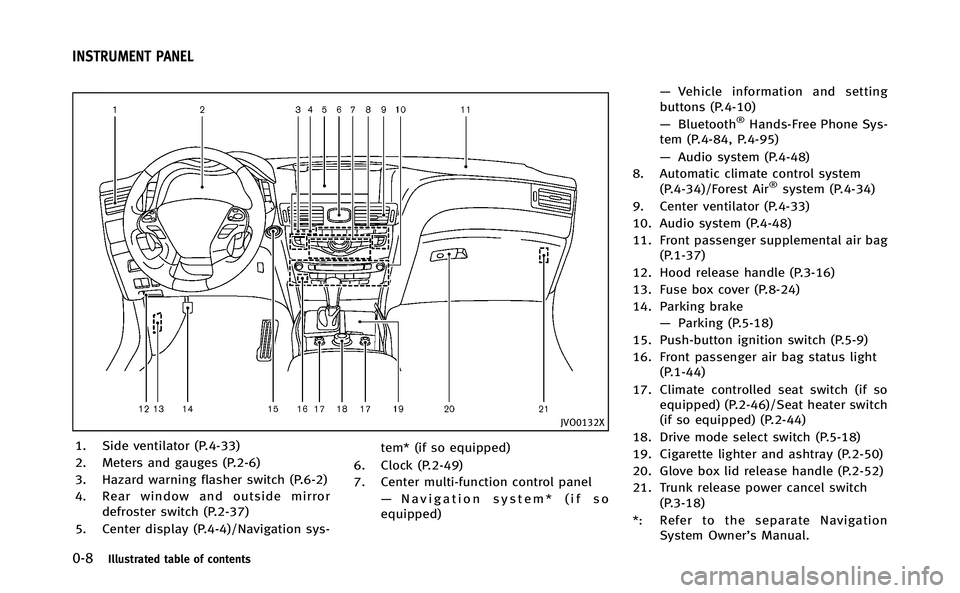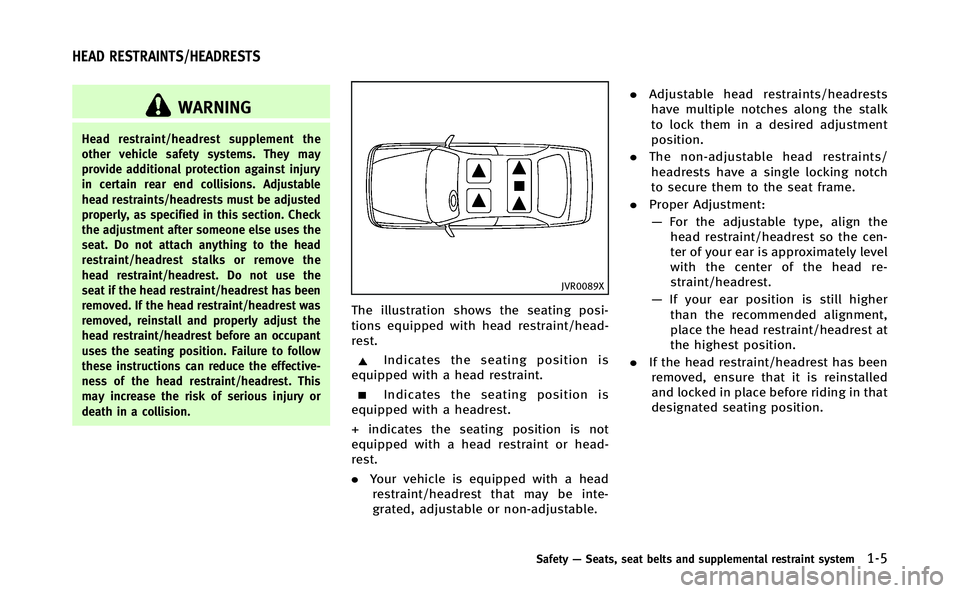lock INFINITI Q70-HYBRID 2014 Owners Manual
[x] Cancel search | Manufacturer: INFINITI, Model Year: 2014, Model line: Q70-HYBRID, Model: INFINITI Q70-HYBRID 2014Pages: 522, PDF Size: 4.01 MB
Page 24 of 522

JVC0142X
1. Hood (P.3-16)
2. Headlight and turn signal—Operation (P.2-38)
— Bulb replacement (P.8-29)
3. Windshield wiper and washer —Operation (P.2-35) —
Maintenance (P.8-21)
4. Moonroof (P.2-57)
5. Power windows (P.2-55)
6. Recovery hook (P.6-15)
7. Fog light (P.2-43)
8. Tires —
Wheel and tires (P.8-32, P.9-8)
— Flat tire (P.6-3)
— Tire pressure monitoring system
(TPMS) (P.2-15, P.5-4)
9. Outside mirrors (P.3-25)
10. Doors —Keys (P.3-2)
— Door locks (P.3-4)
— Intelligent Key system (P.3-6)
— Remote keyless entry system
(P.3-13)
— Welcome light (P.2-60)
Illustrated table of contents0-3
EXTERIOR FRONT
Page 25 of 522

0-4Illustrated table of contents
JVC0258X
1. Trunk—Intelligent Key system (P.3-6)
— Remote keyless entry system
(P.3-13)
— Trunk lid (P.3-17)
— 12-volt battery (P.8-18) 2. High-mounted stop light (bulb repla-
cement) (P.8-29)
3. Rear combination light (bulb replace- ment) (P.8-29)
4. Satellite antenna (P.4-48)
5. Rear window defroster (P.2-37) 6. Sonar system (if so equipped) (P. 5-
93)
7. Rear view camera (P.4-26)
8. Fuel-filler door —Operation (P.3-20)
— Fuel information (P.9-4)
9. Child safety rear door locks (P.3-6)
EXTERIOR REAR
Page 29 of 522

0-8Illustrated table of contents
JVO0132X
1. Side ventilator (P.4-33)
2. Meters and gauges (P.2-6)
3. Hazard warning flasher switch (P.6-2)
4. Rear window and outside mirrordefroster switch (P.2-37)
5. Center display (P.4-4)/Navigation sys- tem* (if so equipped)
6. Clock (P.2-49)
7. Center multi-function control panel —Navigation system* (if so
equipped) —
Vehicle information and setting
buttons (P.4-10)
— Bluetooth
®Hands-Free Phone Sys-
tem (P.4-84, P.4-95)
— Audio system (P.4-48)
8. Automatic climate control system (P.4-34)/Forest Air
®system (P.4-34)
9. Center ventilator (P.4-33)
10. Audio system (P.4-48)
11. Front passenger supplemental air bag (P.1-37)
12. Hood release handle (P.3-16)
13. Fuse box cover (P.8-24)
14. Parking brake —Parking (P.5-18)
15. Push-button ignition switch (P.5-9)
16. Front passenger air bag status light (P.1-44)
17. Climate controlled seat switch (if so equipped) (P.2-46)/Seat heater switch
(if so equipped) (P.2-44)
18. Drive mode select switch (P.5-18)
19. Cigarette lighter and ashtray (P.2-50)
20. Glove box lid release handle (P.2-52)
21. Trunk release power cancel switch (P.3-18)
*: Refer to the separate Navigation System Owner’s Manual.
INSTRUMENT PANEL
Page 32 of 522

Warninglight Name
Page
12-volt batteryCharge warning
light 2-11
Anti-lock Braking System (ABS)
warning light2-11
Blind Spot Warning (BSW)/
Blind Spot Intervention (BSI)
system warning light (orange)*2-11
Brake system warning light
(yellow)
2-12
Brake warning light (red) 2-12
Direct Response Hybrid®Sys-
tem warning light 2-13
Distance Control Assist (DCA)
system warning light (orange)*
2-13
Engine oil pressure warning
light2-13
High temperature warning light 2-14
Hybrid EPS (Electrical Power
Steering) warning light2-14
Intelligent Cruise Control (ICC)
system warning light (orange)*2-14
Lane Departure Warning (LDW)
light (orange)*
2-14
Low tire pressure warning light 2-15 Warning
light Name
Page
Master warning light 2-16
Preview Function warning light
(orange)* 2-16
Seat belt warning light and
chime2-16
Supplemental air bag warning
light
2-17
Vehicle Dynamic Control (VDC)
warning light2-17
Indicator light Name
Page
Adaptive Front lighting System
(AFS) off indicator light* 2-17
Approaching Vehicle Sound for
Pedestrians (VSP) OFF indicator
light2-18
Automatic Transmission (AT)
position indicator light
2-18
Blind Spot Intervention (BSI)
indicator light
(green)*2-18
ECO drive indicator light 2-18
EV indicator light
2-18
Exterior light indicator2-18
Front fog light indicator light 2-18 Indicator
light Name
Page
Front passenger air bag status
light 2-18
High beam indicator light 2-18
Intelligent Brake Assist (IBA) off
indicator light*2-18
Lane Departure Warning (LDW)
light (green)*
2-19
Malfunction Indicator Light
(MIL)2-19
READY to drive indicator light 2-20
Security indicator light 2-20
Turn signal/hazard indicator
lights2-20
Vehicle Dynamic Control (VDC)
off indicator light2-20
*: if so equipped
Illustrated table of contents0-11
WARNING AND INDICATOR LIGHTS
Page 38 of 522

WARNING
Head restraint/headrest supplement the
other vehicle safety systems. They may
provide additional protection against injury
in certain rear end collisions. Adjustable
head restraints/headrests must be adjusted
properly, as specified in this section. Check
the adjustment after someone else uses the
seat. Do not attach anything to the head
restraint/headrest stalks or remove the
head restraint/headrest. Do not use the
seat if the head restraint/headrest has been
removed. If the head restraint/headrest was
removed, reinstall and properly adjust the
head restraint/headrest before an occupant
uses the seating position. Failure to follow
these instructions can reduce the effective-
ness of the head restraint/headrest. This
may increase the risk of serious injury or
death in a collision.
JVR0089X
The illustration shows the seating posi-
tions equipped with head restraint/head-
rest.
Indicates the seating position is
equipped with a head restraint.
Indicates the seating position is
equipped with a headrest.
+ indicates the seating position is not
equipped with a head restraint or head-
rest.
. Your vehicle is equipped with a head
restraint/headrest that may be inte-
grated, adjustable or non-adjustable. .
Adjustable head restraints/headrests
have multiple notches along the stalk
to lock them in a desired adjustment
position.
. The non-adjustable head restraints/
headrests have a single locking notch
to secure them to the seat frame.
. Proper Adjustment:
— For the adjustable type, align the
head restraint/headrest so the cen-
ter of your ear is approximately level
with the center of the head re-
straint/headrest.
— If your ear position is still higher
than the recommended alignment,
place the head restraint/headrest at
the highest position.
. If the head restraint/headrest has been
removed, ensure that it is reinstalled
and locked in place before riding in that
designated seating position.
Safety —Seats, seat belts and supplemental restraint system1-5
HEAD RESTRAINTS/HEADRESTS
Page 39 of 522

1-6Safety—Seats, seat belts and supplemental restraint system
SSS0992
ADJUSTABLE HEAD RESTRAINT/
HEADREST COMPONENTS
1. Removable head restraint/headrest
2. Multiple notches
3. Lock knob
4. Stalks
JVR0203X
NON-ADJUSTABLE HEAD RE-
STRAINT/HEADREST COMPONENTS
1. Removable head restraint/headrest
2. Single notch
3. Lock knob
4. Stalks
SSS1037
REMOVE
Use the following procedure to remove the
head restraint/headrest.
1. Pull the head restraint/headrest up to
the highest position.
2. Push and hold the lock knob.
3. Remove the head restraint/headrest from the seat.
4. Store the head restraint/headrest prop- erly in a secure place so it is not loose
in the vehicle.
5. Reinstall and properly adjust the head restraint/headrest before an occupant
Page 40 of 522

uses the seating position.
SSS0996
INSTALL
1. Align the head restraint/headreststalks with the holes in the seat. Make
sure that the head restraint/headrest is
facing the correct direction. The stalk
with the adjustment notch
*1must be
installed in the hole with the lock knob
*2.
2. Push and hold the lock knob and push the head restraint/headrest down.
3. Properly adjust the head restraint/ headrest before an occupant uses the
seating position.
SSS0997
ADJUST
For adjustable head restraint/headrest
Adjust the head restraint/headrest so the
center is level with the center of your ears.
If your ear position is still higher than the
recommended alignment, place the head
restraint/headrest at the highest position.
Safety —Seats, seat belts and supplemental restraint system1-7
Page 41 of 522

1-8Safety—Seats, seat belts and supplemental restraint system
JVR0259X
For non-adjustable head restraint/head-
rest
Make sure the head restraint/headrest is
positioned so the lock knob is engaged in
the notch before riding in that designated
seating position.
SSS1035
Raise
To raise the head restraint/headrest, pull it
up.
Make sure the head restraint/headrest is
positioned so the lock knob is engaged in
the notch before riding in that designated
seating position.
SSS1036
Lower
To lower, push and hold the lock knob and
push the head restraint/headrest down.
Make sure the head restraint/headrest is
positioned so the lock knob is engaged in
the notch before riding in that designated
seating position.
Page 46 of 522

belt system has a malfunction. Have your
INFINITI retailer check and repair the
system.
When the seat belt is retracted repeatedly
in a short period of time, the motor may
not be able to retract the seat belt. After 8
minutes, the motor normally reactivates
and retracts the seat belt. If the seat belt
still cannot be retracted by the motor, the
pre-crash seat belt system has a malfunc-
tion. Have your INFINITI retailer check and
repair the system.
THREE-POINT TYPE SEAT BELT
WARNING
.Every person who drives or rides in this
vehicle should use a seat belt at all
times.
. Do not ride in a moving vehicle when the
seatback is reclined. This can be danger-
ous. The shoulder belt will not be
against your body. In an accident, you
could be thrown into it and receive neck
or other serious injuries. You could also
slide under the lap belt and receive
serious internal injuries. .
For the most effective protection when
the vehicle is in motion, the seat should
be upright. Always sit well back in the
seat with both feet on the floor and
adjust the seat belt properly.
. Do not allow children to play with the
seat belts. Most seating positions are
equipped with Automatic Locking Re-
tractor (ALR) mode seat belts. If the seat
belt becomes wrapped around a child’s
neck with the ALR mode activated, the
child can be seriously injured or killed if
the seat belt retracts and becomes tight.
This can occur even if the vehicle is
parked. Unbuckle the seat belt to release
the child. If the seat belt can not be
unbuckled or is already unbuckled,
release the child by cutting the seat belt
with a suitable tool (such as a knife or
scissors) to release the seat belt.
SSS0292
Fastening the seat belts
1. Adjust the seat. (See “Seats”(P.1-2).)
2. Slowly pull the seat belt out of the retractor and insert the tongue into the
buckle until you hear and feel the latch
engage.
.The retractor is designed to lockduring a sudden stop or on impact.
A slow pulling motion permits the
belt to move, and allows you some
freedom of movement in the seat.
.If the seat belt cannot be pulledfrom its fully retracted position,
firmly pull the belt and release it.
Safety —Seats, seat belts and supplemental restraint system1-13
Page 47 of 522

1-14Safety—Seats, seat belts and supplemental restraint system
Then smoothly pull the belt out of
the retractor.
SSS0290
3. Position the lap belt portion low and
snug on the hips as shown.
4. Pull the shoulder belt portion toward the retractor to take up extra slack. Be
sure the shoulder belt is routed over
your shoulder and across your chest.
The three-point type seat belts have two
modes of operation:
. Emergency Locking Retractor (ELR)
. Automatic Locking Retractor (ALR)
The Emergency Locking Retractor (ELR)
mode allows the seat belt to extend and
retract to allow the driver and passengers
some freedom of movement in the seat. The ELR locks the seat belt when the
vehicle slows down rapidly or during
impacts.
The Automatic Locking Retractor (ALR)
mode (child restraint mode) locks the seat
belt for child restraint installation.
When the ALR mode is activated the seat
belt cannot be extended again until the
seat belt tongue is detached from the
buckle and fully retracted. The seat belt
returns to the ELR mode after the seat belt
fully retracts. For additional information,
see
“Child restraints” (P.1-19).
The ALR mode should be used only for
child restraint installation. During normal
seat belt use by an occupant, the ALR
mode should not be activated. If it is
activated, it may cause uncomfortable seat
belt tension.
WARNING
When fastening the seat belts, be certain
that seatbacks are completely secured in
the latched position. If they are not com-
pletely secured, passengers may be injured
in an accident or sudden stop.